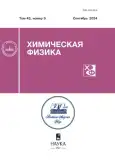Biological activity of carnitine 2-ethyl-6-methyl-3-hydroxypyridine
- Autores: Zhigacheva I.V.1, Rusina I.F.2, Krikunova N.I.1, Veprintsev T.L.1, Kuznetsov Y.V.1, Rasulov M.M.3
-
Afiliações:
- Emanuel Institute of Biochemical Physics, Russian Academy of Sciences
- Semenov Federal Research Center for Chemical Physics, Russian Academy of Sciences
- State Research Institute of Chemistry and Technology of Organoelement Compounds
- Edição: Volume 43, Nº 9 (2024)
- Páginas: 61-68
- Seção: Chemical physics of biological processes
- URL: https://journals.eco-vector.com/0207-401X/article/view/680967
- DOI: https://doi.org/10.31857/S0207401X24090073
- ID: 680967
Citar
Texto integral
Resumo
The antiradical properties and biological activity of carnitine 2-ethyl-6-methyl-3-hydroxypyridine (СP) were investigated. The drug had high antiradical activity. In the concentration range 10-6–10-9M, CP prevented the activation of lipid peroxidation in the membranes of mouse liver mitochondria incubated in a hypotonic medium. Such an incubation caused a change in the fatty acid (FA) composition of the lipid component of mitochondrial membranes: the total relative percentage of 18:2ω6, 18:1ω9 and 22:6ω3 – the main FAs that make up cardiolipin decreased by 8.1%. The introduction of CP into the incubation medium led not only to the restoration of the pool of these FAs, but also to an increase in their content by 15%, which, possibly, contributed to an increase in the efficiency of mitochondrial functioning and an increase in the body’s resistance to stress.
Palavras-chave
Texto integral
Sobre autores
I. Zhigacheva
Emanuel Institute of Biochemical Physics, Russian Academy of Sciences
Autor responsável pela correspondência
Email: zhigacheva@mail.ru
Rússia, Moscow
I. Rusina
Semenov Federal Research Center for Chemical Physics, Russian Academy of Sciences
Email: zhigacheva@mail.ru
Rússia, Moscow
N. Krikunova
Emanuel Institute of Biochemical Physics, Russian Academy of Sciences
Email: zhigacheva@mail.ru
Rússia, Moscow
T. Veprintsev
Emanuel Institute of Biochemical Physics, Russian Academy of Sciences
Email: zhigacheva@mail.ru
Rússia, Moscow
Y. Kuznetsov
Emanuel Institute of Biochemical Physics, Russian Academy of Sciences
Email: zhigacheva@mail.ru
Rússia, Moscow
M. Rasulov
State Research Institute of Chemistry and Technology of Organoelement Compounds
Email: zhigacheva@mail.ru
Rússia, Moscow
Bibliografia
- V.E. Pozhilova, E.V., Novikov, O.S Levchenkova. Bulletin of the Smolensk State Med. Academies. 14 (2). 13-21 (2015).
- C. Munoz-Pinedo, A. Guıo-Carrion, J.C. Goldstein et al. PNAS. 103 (31). 11573–11581 (2006).
- Maureen Redza-Dutordoir, Diana A. Averill-Bates. BBA. Molecular Cell Research. 1863 (12). 2977-2992 (2016).
- M. Schieber, N.S. Chandel. Curr. Biol. 24 (10). R453–R462 (2014). https://doi.org/10.1016/j.cub.2014.03.034
- V.E. Novikov and S.O. Losenkova. Reviews on clinical pharmacology and medicinal. therapy. 3 (I). 2-14 (2004).
- V.Ya. Shlyapintokh, O.N. Karpukhin, L.M.Postnikov et al. Chemi-luminescent methods for studying slow chemical processes.(M., Science, 1966).
- E.N. Mokhova, V.P. Skulachev, I.V. Zhigacheva. BBA. 501 (3). 415-423 (1978). https://doi.org/10.1016/0005-2728(78)90109-3
- B.I. Fletcher, C.D. Dillard, A.L. Tappel. Anal. Biochem. 52. 1–9 (1973).
- J.P. Carreau, J.P. Dubacq. J Chromatogr. 151 (3). 384-390 (1979). doi: 10.1016/S0021-9673(00)88356-9Get.
- J. Wang, H. Sunwoo, G. Cherian, I. S. Sim. Poult. Sci. 79 (8). 1168-1171 (2000). https://doi.org/10.1093/ps/79.8.1168
- R.V. Golovina, T.E. Kuzmenko. Сhromatogr. 10 (9). 545–546. (1977).
- I.F. Rusina, O.N. Karpukhin, O.T. Kasaikina. Russian Journal of Physical Chemistry B 7 (4). 53 (2013).
- I.F. Rusina, T.L. Veprintsev, and R.F. Vasil’ev. Russian Journal of Physical Chemistry B 16 (1), 50-57 (2022) https://doi.org/10.1134/S1990793122010274
- I.V. Zhigacheva, V.I. Binyukov, I.F. Rusina et al. Russian Journal of Physical Chemistry B 14 (4). 41–48 (2020).
- D.B. Zorov, N.K. Isaev, E.Yu. Plotnikov et al. Biochemistry (Moscow). 72. 1371 (2007)
- A. Aronis, R. Komarnitsky, Shani Shilo et al. Antioxidant and redox signaling. 4(4). 647.(2004).
- B.O’Rourke. Annual Review of Physiol. 69. 19. (2007).
- G.A. Shilovsky, T.S. Putyatina, V.V. Ashapkin et al. Biochemistry (Moscow). 84 (12). 1815–1831. (2019).
- K.M. Dyumaev, L.D. Smirnov. Advances in Chemistry. 44 (10). 1788.(1975)
- K. Nomura., H. Imai, T. Koumura et al. Biochem J. 351. 183–193. (2000).
- E.I. Astashkin, M.G. Glazer // Medical Council. 10. 104–110. (2016).
- G.Paradies, V.Paradies , F. M.Ruggiero, G.Petrosillo // Cells. 2019. 8 (7). 728. https://doi.org/10.3390/cells8070728
- E.B. Burlakova, N.M. Storozhok, N.G. Khrapova //Chemical kinetics. 14(11). 29 (1995)
Arquivos suplementares













